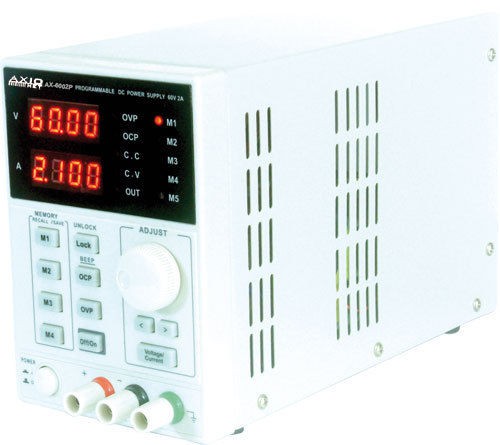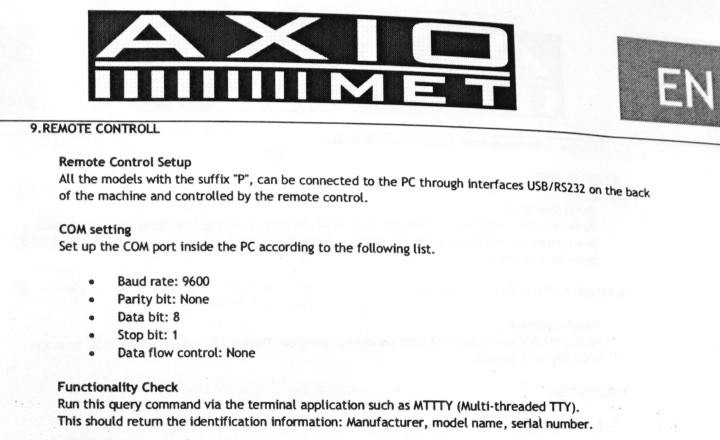So now I can generate 61V@2.1A though I can't seem to control it via USB. Yet.
But it's already a game-changer for my lab :-D
Update 20170417 : the stack entry has been deleted :-(
I had noted a few things, I'll try to remember them and write them down here.
Update 2: ah no, it's there : https://hackaday.io/page/3068-advicesinfos-about-usb-connected
But it's good to have a second copy ;-)

The model is AXIOMET AX6002, a rebranding, as I later found, of KORAD KA6002, but discovery was not obvious.
I bought this model on eBay because
- it reaches 60V (a match for the pentodes)
- it's digital, easy to set precisely
- it's not much more expensive than other models
- it is interfaced with serial and USB ports !
4th sealed the deal.
When plugged in the computer, the serial port is immediately found (OK, I first have a dud cableso it wasn't as smooth.
The documentation is quite terse:

I have the protocol (9600 8N1) so I can configure the port:
TTY=/dev/ttyACM3 stty 9600 cs8 raw -echo -echoe -echonl -echoprt -echoctl -echoke -parenb -F $TTY
but the last paragraph misses a critical information : what query to enter ?
I went to the Axiomet website too look for information and found the newer model. The documentation mentions:
Interface:USB interface, SCPI commands provided
Oh, let's look that up. SCPI is a standard I hadn't spotted yet ! So I embark in the analysis of the specifications.
I find that the discovery string is "*IDN?" so I try to read it:
echo -n "*IDN?" > $TTYIt took a while to get anything, and to understand that contrary to the specification, the commands should not be terminated by CR/LF, so I added the "-n" option to echo.
# in another term: $ od -An -v -w1 -t x1 $TTY 4b 4f 52 41 44 4b 41 36 30 30 32 50 56 32 2e 30 00
In ASCII :
$ cat $TTY KORADKA6002PV2.0
After a few hours, I got the device's string, that returned no hit on google...
So I wrote a .stack page (unfortunately deleted now) and asked for help. I got it (from @Andrew Bolin) with a link that started bring sense to the whole situation because I tried most of the standard commands without finding anything else that would work, with or without the trailing CR/LF.
On the EEVBlog,I find that the device is not KORADKA but the brand KORAD, model KA6002P !
I learn about the bug (reproduced here) with the trailing letter, then discover the whole command set.
(the most important are copy-pasted here)
| Request | Example output | Remarks |
|---|---|---|
| *IDN? | KORADKA3005PV2.0 VELLEMANPS3005DV2.0 VELLEMANLABPS3005DV2.0 |
Request identification from device. |
| VSET1? | 12.34 | Request the voltage as set by the user. |
| VSET1:12.34 | (none) | Set the maximum output voltage. |
| VOUT1? | 12.34 | Request the actual voltage output. |
| ISET1? | 0.125 | Request the current as set by the user. See notes below for a firmware bug related to this command. |
| ISET1:0.125 | (none) | Set the maximum output current. |
| IOUT1? | 0.125 | Request the actual output current. |
| OUT1 | (none) | Enable the power output. |
| OUT0 | (none) | Disable the power output. |
| OVP1 | (none) | Enable the "Over Voltage Protection", the PS will switch off the output when the voltage rises above the actual level. |
| OVP0 | (none) | Disable the "Over Voltage Protection". |
| OCP1 | (none) | Enable the "Over Current Protection", the PS will switch off the output when the current rises above the actual level. |
| OCP0 | (none) | Disable the "Over Current Protection". |
I see several project that interface to the same line of devices, in Python and Ruby for example, but the thing is now very simple to command, even with bash. Here is a little "vocabulary" :
echo -n "*IDN?" > $TTY
echo -n "ISET1?" > $TTY
echo -n "OCP0" > $TTY
echo -n "OCP1" > $TTY
echo -n "OUT0" > $TTY
echo -n "OUT1" > $TTY
echo -n "OVP0" > $TTY
echo -n "OVP1" > $TTY
echo -n "ISET1:0" >> $TTY
echo -n "VSET1:0" >> $TTY
echo -n "STATUS?" > $TTY
echo -n "VOUT1?" > $TTY
echo -n "VSET1?" > $TTY
# ramp up the voltage from 0 to 60V
for i in $(seq -w 0 60)
do
echo -n "VSET1:"$i >> $TTY
sleep .1
done
#ramp up the current from 0 to 999mA
for i in $(seq -w 0 999)
do
echo -n "ISET1:0."$i >> $TTY
echo $i
sleep .1
done
So these are not actual standard-compliant SCPI commands but they are good candidates for transport over #HTTaP
 Yann Guidon / YGDES
Yann Guidon / YGDES
Discussions
Become a Hackaday.io Member
Create an account to leave a comment. Already have an account? Log In.
I dont know much about tubes. So they run at 60+V? Wow!
Are you sure? yes | no
at least the miniature pentodes, see my update at https://hackaday.io/project/20733-hot-logic/log/56575-129-1j29b-v-arrived-too
There is another required voltage for the 2nd grid: 45V. WTF.
Are you sure? yes | no
Which is on the very low end of the scale for tubes. Often they need ~300V, some transmitter tubes run on 1500V or the really big ones from a 600kW (AM, medium wave) transmitter used 14kV. The VFDs, which are technically triodes use 15 to 30V anode voltage
Are you sure? yes | no
Do the big ones have significant X-ray output?
Are you sure? yes | no
@ Andrew Starr:
The range of X-rays with an energy of 5 to 20keV is considered "very soft x-rays", so it is possible, but I don't know.
Are you sure? yes | no
Thats crazy! Im used to my 5v stuff so massive voltages like that are completely nuts to me.
Are you sure? yes | no
and i'm here with only a 60V PSU :-D
Are you sure? yes | no